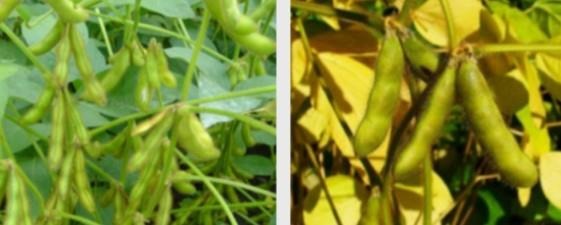By Alvaro Garcia
Dry conditions and pasture shortages force livestock producers to either sell animals or look for alternative feeds. Oilseed crops may be harvested for forage when dry conditions have shrunk their yields below the economic threshold for seed harvest or when facing forage shortages. Alternative forages like soybean silage or hay, and sunflower silage, can help stretch conventional forage supplies and/or help avoid overgrazing pasture. How to harvest alternative crops for forage depends on the individual crop and its stage of maturity. Since soybeans are legumes, they contain greater amounts of protein compared to corn silage and other small grain silages. The major limitation is that only a few herbicides used in soybeans for seed are cleared to be fed to cattle. Always verify herbicide restrictions when using soybeans for forage.
Baled Soybeans
Soybeans can make great feed when harvested for forage. The nutritive value of a soybean plant can be comparable to early-bloom alfalfa. Cows and growing heifers can have similar performance when given either soybean hay or alfalfa forage. Palatability is not usually a problem unless the forage is moldy, dusty, or too mature. Soybeans should be baled when the pods are almost full of seeds and the lower leaves are just starting to turn yellow but are not falling off (Figure 1). At this maturity stage, digestibility of the pods exceeds that of the stems by as much as 25 percentage units, contributing significantly to the overall nutritive value of the whole plant. As stems tend to dry slowly, conditioning will achieve similar dehydration rate of stems and leaves, and bring total moisture below 25%. Rake no more than absolutely needed, as leaves and pods tend to shatter easily.

Figure 1. (Above) Soybean plants almost ready to bale.
Soybean Silage
As with other silages moisture content is important if one chooses this preservation alternative. The moisture recommendation is similar to that of alfalfa silage and close to 55 to 65%. The use of a good silage fermentation aid is recommended. For soybeans, this occurs right before the pods are full (Figure 2). Waiting until complete maturity results in a forage of lower digestibility and can lead to fermentation problems due to the high oil content of the seeds and the difficulty in packing the silage. If available, mixing one-third chopped corn plants with the chopped soybean forage helps overcome these problems. Corn plants provide soluble sugars that help with fermentation and dilute the fat of the soybeans.

Figure 2. Soybean plants to ensile (left) and too mature (right).
Moisture Content
Direct-cut soybeans may have moisture contents between 70 and 88%. Ensiling at this moisture will result in higher effluent losses and a greater risk of undesirable fermentation (butyric). It is better to aim for 60-65% moisture. Less moisture than recommended will lead to difficulty in packing, air infiltration, and heating. In addition, the buffering capacity of the crop is relatively high which might hinder fermentation. Inoculants can help reduce these problems and inhibit mold growth.
Nutrient Content
The nutrient content of soybean silage can be greater than most other forages, such as corn silage and small grain silages. Dry matter digestibility can be up to 77%, with NDF digestibility up to 47.8% making this silage a forage with overall good digestibility. Soybean silage can also be a good source of minerals such as calcium and phosphorus (Table 1). It averages approximately 19% CP, with a soluble protein concentration that varies depending on the moisture concentration. Harvesting at earlier maturities increases CP concentrations, depending on the stage of development of the plants. Its fiber (NDF, ADF, and lignin; Table 1) and non-fiber carbohydrate (NFC) concentrations vary depending on the maturity at which the crop was harvested. As a result, soybean silage can range from being a moderate fiber, high NFC to a high fiber, low NFC feedstuff. Fat concentration ranges from 2.3 to 6.6%, depending upon the stage of maturity of the soybean in the pods. Given the ranges in quality that could be expected based on the maturity of the soybean plants, a sample should be submitted to the laboratory for nutrient content and digestibility analyses.
Table 1. Nutrient composition of soybean silage.
| | Range |
| Crude protein, % | 16.0 - 20.6 |
| Neutral detergent fiber, % | 38.3 - 48.3 |
| Acid detergent fiber, % | 27.3 - 37.3 |
| Acid detergent lignin | 6.0 - 7.4 |
| Calcium, % | 1.36 - 1.49 |
| Phosphorus, % | 0.26 - 0.31 |
Two varieties averaged over two years. Adapted from Coffey et. al. 1995. ARPAS 11:74
Herbicide Restrictions
Always verify herbicide restrictions when using soybeans for forage (Table 2). Soybean silage can be ensiled very easily and a good silage inoculant is recommended to aid in the ensiling process. Lactic acid concentrations can range from low to high, and adequate pH values can be attained to ensure long term storage. In addition, the concentrations of lactic and acetic acids, along with a low pH, ensure soybean silage will be very stable during feed out in the feed bunk. Soybeans can be easily ensiled as a high-quality forage.
Click here to see more...